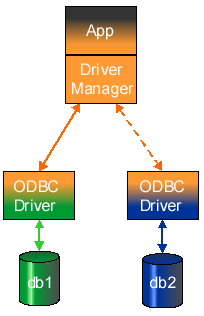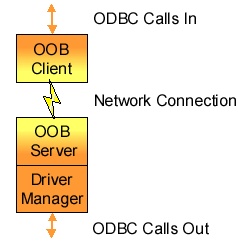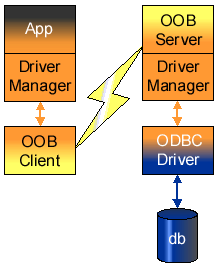
Easysoft Data Access is a suite of programs that add significant value to your investment in ODBC. With Easysoft software you can connect applications on more platforms to more database systems than ever before.
The Easysoft ODBC-ODBC Bridge (OOB) enables ODBC calls to be made across the network from any Windows or Unix system to an ODBC data source running under Windows or Unix, permitting heterogeneous client-server operation and allowing client access to data wherever it is stored.
Please note that if you want to connect to local data sources from a remote Java application, you will need the Easysoft JDBC-ODBC Bridge instead of this software.
Historically, corporate data was held on large, centralized computing resources that performed all the processing required on it. Changes to the business practice meant changes had to be made to the corporate mainframe system. Worse still was the problem of integrating two or more of these highly individual systems, for example in the event of a corporate merger.
As the desktop computer improved in power, users began to want to access corporate data in order to process it on their own desktop. The client-server architecture became a popular goal: the central computing resource (server) would produce a subset of its data for a user-friendly tool (client). The client would use desktop computing power to format and present the data.
Database application writers and their customers found themselves with a key problem: it was necessary to produce one version of a piece of software for each DataBase Management System (DBMS) they wished to use it with. Relational databases and SQL went part way toward alleviating the problem and for the first time there was a defined, open, standard language for querying databases.
In theory at least, it was possible to use the same language in dealing with databases from a variety of manufacturers and the X/Open consortium went on to define a Call Level Interface (CLI) so that programmers could effectively use SQL within their own programs.
ODBC is an API definition, compliant with ANSI SQL and X/Open's SQL CLI, which allows an application to be written without considering the intricacies of the particular database engine to which it connects.
An ODBC driver takes care of all the database-specific code, if necessary transforming the structure of the underlying system into a relational framework.
illustrates the principle of separating the driver from the application.
The left-hand side of the diagram shows how before ODBC, even if App1 and App2 were functionally equivalent, two programs were required, one for each DBMS.
The right-hand side of the diagram shows how ODBC permits the DBMS-specific parts of a program to be separated from the part that fulfils the functional requirement, enabling the completed application to be attached to any DBMS that has a corresponding driver.
The barest ODBC system would include an ODBC-conformant driver accessing some data, and an ODBC-conformant application, linked to the driver library.
If commercial applications were distributed in this way, users would need to re-link their applications to their chosen driver whenever they wanted to access a different data source.
Instead, the application program is linked to a driver manager, which loads the required driver at runtime.

This approach provides three key results:
The Easysoft ODBC-ODBC Bridge is data access middleware that allows an application running on one platform to access an ODBC data source on another platform.
A sales manager keeps the company sales figures in an Excel spreadsheet on his networked Windows NT PC. He enjoys the consistent user interface and flexibility of the Windows system.
The company also has an intranet running on an Apache server under Linux, which displays the latest sales figures and updates them daily.
The system administrator values the round-the-clock stability of the Linux platform and the ability to freely tailor and tune the server software.
At present the sales manager emails the latest figures to the web site administrator at the end of each day and then the web site administrator updates the intranet.
The Easysoft ODBC-ODBC Bridge allows a script on the web server to run a SQL select query directly on the NT machine, removing the need for regular human intervention.
A small script along with a simple client program submits SQL to the Easysoft ODBC-ODBC Bridge, which passes it across to the spreadsheet software on the NT machine. The script is set up to trigger automatically at the end of the day.
The Easysoft ODBC-ODBC Bridge comes in two parts, a client and a server.
The OOB Client appears to the ODBC application just as any other ODBC driver, and the OOB Server connects to the database engine as an ODBC application.
This terminology may seem a little confusing at first, so it is important to consider each element step by step.
First, shows the typical ODBC set up. The application ("App") connects through a driver manager to an ODBC driver, which interfaces to the DBMS. The interface between the driver manager and the driver is defined by the ODBC API.
The Easysoft ODBC-ODBC Bridge can be seen as a black box that takes ODBC calls in at the top and passes them out again at the bottom.
This box can be inserted at A and as far as the application or the database are concerned, nothing has changed:

What haschanged is that now the driver manager, loads the OOB Client and the application and database no longer need to be on the same machine or software platform.
|
Connecting an ODBC application to a networked database is not new. For example, Microsoft SQL Server allows ODBC client applications to connect to a remote SQL Server data source. With the Easysoft ODBC-ODBC Bridge, however, the database can be any ODBC data source and the client may be on Windows, Linux, Solaris or any other supported platform. |
Inside this `black box' is a client-server pair that handles all the network operations, passing function references and parameters one way and return values the other:

shows the system set up across a network.
Comparing it with the model in , the database is replaced by a network connection on the client side and the OOB Server replaces the ODBC applicationon the server side.
|
The OOB Server does not have to be on the same machine as your database if you have an ODBC driver for your database available on another machine. |

|
The definitive SQL CLI document is the Open Group CAE Specification C451, ISBN 1-85912-081-4. The Microsoft ODBC 3.0 Programmer's Reference, ISBN 1-57231-516-4explains ODBC usage in some detail. |
Oracle is a registered trademark of Oracle Corporation and/or its affiliates.